【一文打尽 ICLR 2018】9大演讲,DeepMind、谷歌最新干货抢鲜看

转载自 | 新智元
编辑 | 磐石
出品 | 磐创AI技术团队
来源 | iclr、Google/DeepMind blog
【磐创AI导读】:本文授权转载自新智元。主要介绍了ICLR2018相关亮点。欢迎大家点击上方蓝字关注我们的公众号:磐创AI。
ICLR 2018即将开幕,谷歌、DeepMind等大厂这几天陆续公布了今年的论文,全是干货。连同3篇最佳论文和9个邀请演讲一起,接下来将带来本届ICLR亮点的最全整理。
ICLR 2018即将在明天(当地时间4月30日)在温哥华开幕,谷歌、DeepMind等大厂这几天陆续公布了今年的论文,全是干货。本文将同时介绍3篇最佳论文一起。
ICLR 2018为期4天,5月3日结束。与往年一样,本次大会每天分上午下午两场。每场形式基本一样,先是邀请演讲(invited talk),然后是讨论,也就是被选为能够进行口头发表(Oral)的论文、茶歇、海报展示(poster)。
邀请演讲列表:
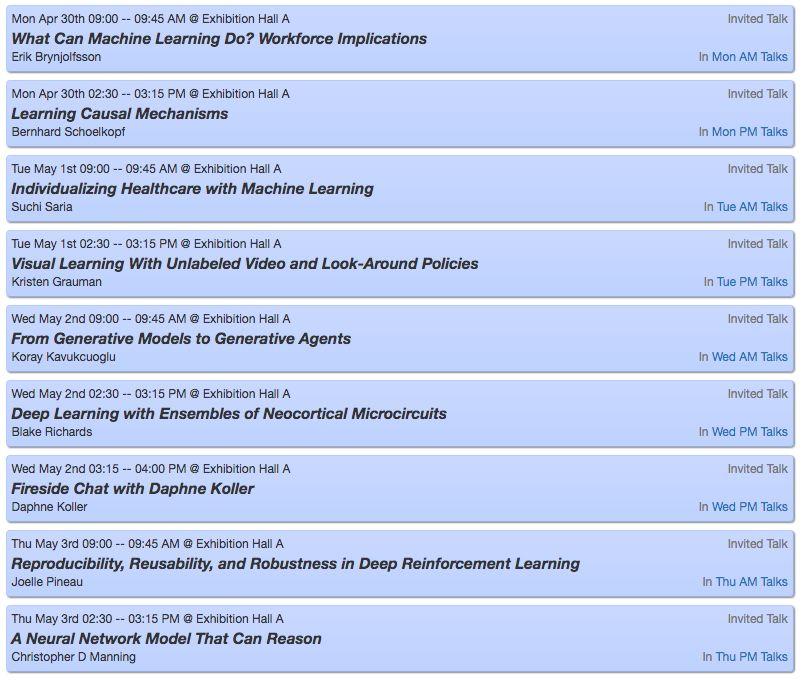
9个邀请演讲主题:
-
Erik Brynjolfsson:机器学习能做什么? 劳动力影响
-
Bernhard Schoelkopf:学习因果机制
-
Suchi Saria:通过机器学习将医疗个性化
-
Kristen Grauman:未标记的视频的视觉学习与环视策略
-
Koray Kavukcuoglu:从生成模型到生成agents
-
Blake Richards:深度学习与Neocortical Microcircuits
-
Daphne Koller:与Daphne Koller的炉边聊天
-
Joelle Pineau:深度强化学习中的可重复性,可重用性和鲁棒性
-
Christopher D Manning:一个可以推理的神经网络模型
大会主席
Yoshua Bengio,蒙特利尔大学
Yann LeCun,纽约大学&Facebook
高级程序主席
Tara Sainath,Google
程序主席
Iain Murray,爱丁堡大学
Marc’Aurelio Ranzato,Facebook
Oriol Vinyals,Google DeepMind
指导委员会
Aaron Courville,蒙特利尔大学
Hugo Larochelle,Google
领域主席(Area Chairs)

最佳评审人:
Amir-massoud Farahmand,Andrew Owens,David Kale,George Philipp,Julien Cornebise,Michiel van de Panne,Tom Schaul,Yisong Yue
ICLR素有深度学习顶会“无冕之王”之称。Dataviz网站之前统计了今年的ICLR数据,有以下几个有意思的地方:
-
来自加州大学伯克利分校的Sergey Levine被接收论文数量最多;
-
大神Bengio提交论文数量最多;
-
谷歌的接收和提交论文数量都属机构第一;
-
英伟达的接收率排名第一;
-
提交和被接收论文数量,英国都独占鳌头;
-
中国是继英国之后,提交论文数量最多的国家。
接收论文数量最多的机构:谷歌第一、伯克利第二、斯坦福第三
如果一篇论文的所有作者都来自同一个机构,该机构被算作写了一篇论文。如果三位作者中只有一位来自该机构,则认为该机构写了三分之一篇论文。
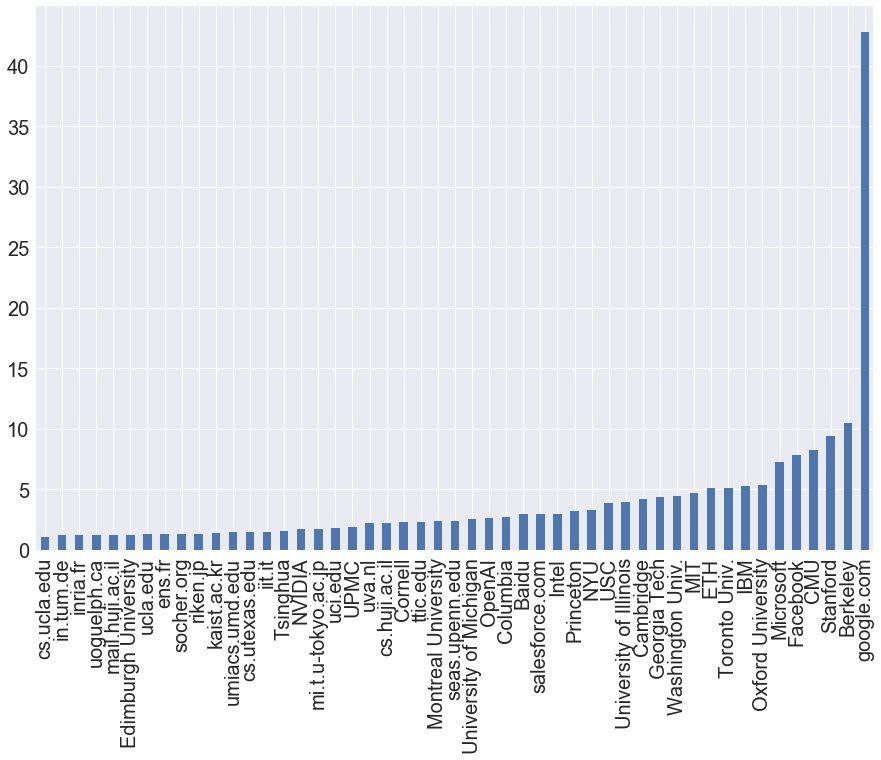
谷歌以3.33篇oral、42.78篇poster和0.56的接收率称霸榜首;伯克利名列第二,oral为2.56篇、poster为10.48篇,接收率为0.46;斯坦福排名第三,oral为1篇,poster为9.4篇,接收率为0.36。
前10名余下机构分别是:CMU、Facebook、微软、牛津大学、IBM、多伦多大学、ETH。
以下带来ICLR 2018的最佳论文的介绍,以及DeepMind和谷歌的论文概况。
论文下载地址:
https://deepmind.com/blog/deepmind-papers-iclr-2018/
https://research.googleblog.com/2018/04/google-at-iclr-2018.html
最佳论文1:
On the Convergence of Adam and Beyond
关于 Adam 算法收敛性及其改进方法的讨论
作者:Sashank J. Reddi, Satyen Kale, Sanjiv Kumar
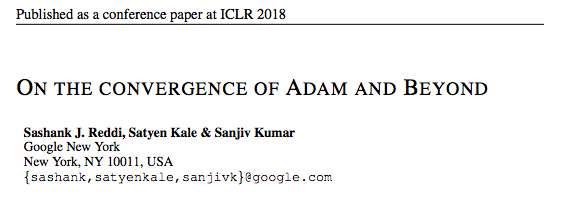
本研究的贡献:
-
通过一个简单的凸优化问题阐述了TMSprop和Adam中使用的指数移动平均是如何导致不收敛的。而且文中的分析可以扩展到其他的指数移动平均打的方法上如Adadelta和NAdam。
-
为了保证算法的收敛,文中使用历史梯度的“长时记忆”。并指出了在以往论文Kingma&Ba(2015)中关于Adam收敛性证明过程中存在的问题。为了解决这个问题,文中提出了Adam的变体算法,算法在使用历史梯度的“长时记忆”的情况下,并没有增加算法的时间复杂度与空间复杂度。此外,文中还基于Kingma&Ba(2015)给出了Adam算法收敛性的分析。
-
提供了Adam算法变体的实验证明,结果表明,在某些常用的机器学习问题中,这个变体的表现算法相似或优于原始算法。
最佳论文2:
球形卷积神经网络(Spherical CNNs)

卷积神经网络(CNN)可以很好的处理二维平面图像的问题。然而,对球面图像进行处理需求日益增加。例如,对无人机、机器人、自动驾驶汽车、分子回归问题、全球天气和气候模型的全方位视觉处理问题。将球形信号的平面投影作为卷积神经网络的输入的这种天真做法是注定要失败的,如下图1所示,而这种投影引起的空间扭曲会导致CNN无法共享权重。
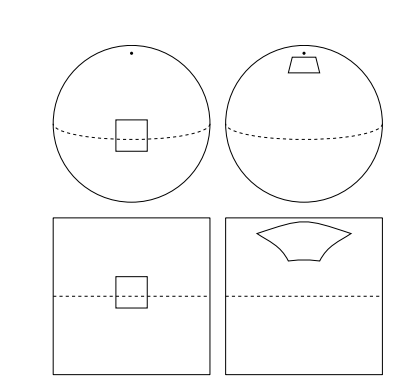
图1
这篇论文中介绍了如何构建球形CNN的模块,提出了利用广义傅里叶变换(FFT)进行快速群卷积(互相关)的操作。通过傅里叶变换来实现球形CNN的示意图如下所示:

最佳论文3:
Continuous Adaptation via Meta-learning in Nonstationary and Competitive Environments
在非固定和竞争环境中通过元学习进行持续性适应
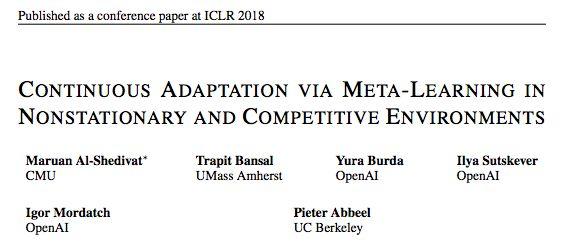
在非平稳环境中不断学习和适应有限经验的能力是计算机通往真正的人工智能的重要里程碑。此文提出了“learning to learn”框架的持续性适应问题。通过设计一种基于梯度的元学习算法来对动态变化和对抗性场景的进行适应。此外,文中还设计了一种基于多智能体(multi-agent)的竞争环境:RoboSumo,并定义了适应性迭代游戏,用于从不同方面测试系统的持续适应性能。实验证明,元学习比在few-shot状态下的反应基线具有更强的适应能力,且适应于进行multi-agent学习和竞争。
实验中使用了三种模型作为智能体(agent),如图1(a) 所示。它们在解剖学上存在差异:腿的数量,位置,以及对大腿和膝关节的限制。下图表示非平稳运动环境。应用于红颜色的腿的扭矩是由一个动态变化的因素决定的。(c)用于表示 RoboSumo竞争环境。

最大后验策略优化
Maximum a posteriori policy optimisation
作者:Abbas Abdolmaleki, Jost Tobias Springenberg, Nicolas Heess, Yuval Tassa, Remi Munos
高效架构搜索的层次化表示
Hierarchical representations for efficient architecture search
作者:Hanxiao Liu (CMU), Karen Simonyan, Oriol Vinyals, Chrisantha Fernando, Koray Kavukcuoglu
一个可迁移机器人技能的嵌入空间学习
Learning an embedding space for transferable robot skills
作者:Karol Hausman, Jost Tobias Springenberg, Ziyu Wang, Nicolas Heess, Martin Riedmiller
有意识模型的学习
Learning awareness models
作者:Brandon Amos, Laurent Dinh, Serkan Cabi, Thomas Rothörl, Sergio Gómez Colmenarejo, Alistair M Muldal, Tom Erez, Yuval Tassa, Nando de Freitas, Misha Denil
重复神经网络的曲率近似法
Kronecker-factored curvature approximations for recurrent neural networks
作者:James Martens, Jimmy Ba (Vector Institute), Matthew Johnson (Google)
分布式分布确定性策略梯度
Distributed distributional deterministic policy gradients
作者:Gabriel Barth-maron, Matthew Hoffman, David Budden, Will Dabney, Daniel Horgan, Dhruva Tirumala Bukkapatnam, Alistair M Muldal, Nicolas Heess, Timothy Lillicrap
Kanerva机器:一个生成的分布式内存
The Kanerva Machine: A generative distributed memory
作者:Authors: Yan Wu, Greg Wayne, Alex Graves, Timothy Lillicrap
基于内存的参数适应
Memory-based parameter adaptation
作者:Pablo Sprechmann, Siddhant Jayakumar, Jack Rae, Alexander Pritzel, Adria P Badia · Benigno Uria, Oriol Vinyals, Demis Hassabis, Razvan Pascanu, Charles Blundell
SCAN:学习层次组合的视觉概念
SCAN: Learning hierarchical compositional visual concepts
作者:Irina Higgins, Nicolas Sonnerat, Loic Matthey, Arka Pal, Christopher P Burgess, Matko Bos ̌njak, Murray Shanahan, Matthew Botvinick, Alexander Lerchner
从带有符号和像素输入的引用游戏中出现语言通信
Emergence of linguistic communication from referential games with symbolic and pixel input
作者:Angeliki Lazaridou, Karl M Hermann, Karl Tuyls, Stephen Clark
通向平衡之路:GAN不需要在每一步中减少散度
Many paths to equilibrium: GANs do not need to decrease a divergence at every step
作者:William Fedus (Université de Montréal), Mihaela Rosca, Balaji Lakshminarayanan, Andrew Dai (Google), Shakir Mohamed, Ian Goodfellow (Google Brain)
神经网络能理解逻辑推理吗?
Can neural networks understand logical entailment?
作者:Richard Evans, David Saxton, David Amos, Pushmeet Kohli, Edward Grefenstette
分布式优先体验重现
Distributed prioritized experience replay
作者:Daniel Horgan, John Quan, David Budden, Gabriel Barth-maron, Matteo Hessel, Hado van Hasselt, David Silver
The Reactor:一个用于强化学习的快速、高效的表现“评论家“
The Reactor: A fast and sample-efficient actor-critic agent for reinforcement learning
作者:Audrunas Gruslys, Will Dabney, Mohammad Gheshlaghi Azar, Bilal Piot, Marc G Bellemare, Remi Munos
关于单一方向泛化的重要性
On the importance of single directions for generalization
作者:Ari Morcos, David GT Barrett, Neil C Rabinowitz, Matthew Botvinick
循环神经网络语言模型中的内存架构
Memory architectures in recurrent neural network language models
作者:Dani Yogatama, Yishu Miao, Gábor Melis, Wang Ling, Adhiguna Kuncoro, Chris Dyer, Phil Blunsom
few-shot自回归密度估计:学习如何学习分布
Few-shot autoregressive density estimation: Towards learning to learn distributions
作者:Scott Reed, Yutian Chen, Thomas Paine, Aaron van den Oord, S. M. Ali Eslami, Danilo J Rezende, Oriol Vinyals, Nando de Freitas
最优神经网络模型的评估
On the state of the art of evaluation in neural language models
作者:Gábor Melis, Chris Dyer, Phil Blunsom
通过谈判的紧急沟通
Emergent communication through negotiation
作者:Kris Cao, Angeliki Lazaridou, Marc Lanctot, Joel Z Leibo, Karl Tuyls, Stephen Clark
基于原始视觉输入的组合式通信学习
Compositional obverter communication learning from raw visual input
作者:Edward Choi, Angeliki Lazaridou, Nando de Freitas
噪声勘探网络
Noisy networks for exploration
作者:Meire Fortunato, Mohammad Gheshlaghi Azar, Bilal Piot, Jacob Menick, Matteo Hessel, Ian Osband, Alex Graves, Volodymyr Mnih, Remi Munos, Demis Hassabis, Olivier Pietquin, Charles Blundell, Shane Legg
在神经网络和深度学习技术创新的前沿,谷歌专注于理论和应用研究,开发用于理解和概括的学习方法。作为ICLR 2018的白金赞助商,谷歌将有超过130名研究人员参加组委会和研讨会,通过提交论文和海报,为更广泛的学术研究社区作出贡献和向其学习。
下面的列表是谷歌在ICLR 2018上展示的研究成果:
口头报告:
Wasserstein Auto-Encoders
Ilya Tolstikhin,Olivier Bousquet,Sylvain Gelly,Bernhard Scholkopf
On the Convergence of Adam and Beyond (Best Paper Award)
关于 Adam 算法收敛性及其改进方法的讨论(最佳论文奖)
作者:Sashank J. Reddi, Satyen Kale, Sanjiv Kumar
Ask the Right Questions: Active Question Reformulation with Reinforcement Learning
提出正确的问题:用强化学习激活问题的重构
作者:Christian Buck, Jannis Bulian, Massimiliano Ciaramita, Wojciech Gajewski, Andrea Gesmundo, Neil Houlsby, Wei Wang
Beyond Word Importance: Contextual Decompositions to Extract Interactions from LSTMs
超越单词重要性:在 LSTM 中用语境分解推断单词之间的相互作用
作者:W. James Murdoch, Peter J. Liu, Bin Yu
大会Poster列表:
Boosting the Actor with Dual Critic
Bo Dai, Albert Shaw, Niao He, Lihong Li, Le Song
MaskGAN: Better Text Generation via Filling in the _______
MaskGAN:通过填写_______更好地生成文本
William Fedus, Ian Goodfellow, Andrew M. Dai
Scalable Private Learning with PATE
用PATE进行可扩展的私人化学习
Nicolas Papernot, Shuang Song, Ilya Mironov, Ananth Raghunathan, Kunal Talwar, Ulfar Erlingsson
Deep Gradient Compression: Reducing the Communication Bandwidth for Distributed Training
深度梯度压缩:降低分布式训练的通信带宽
Yujun Lin, Song Han, Huizi Mao, Yu Wang, William J. Dally
Flipout: Efficient Pseudo-Independent Weight Perturbations on Mini-Batches
Flipout:Mini-Batches上的高效伪独立权重扰动
Yeming Wen, Paul Vicol, Jimmy Ba, Dustin Tran, Roger Grosse
Latent Constraints: Learning to Generate Conditionally from Unconditional Generative Models
潜在约束:学习从无条件生成模型实现有条件生成
Adam Roberts, Jesse Engel, Matt Hoffman
Multi-Mention Learning for Reading Comprehension with Neural Cascades
利用神经级联进行阅读理解的多义学习
Swabha Swayamdipta, Ankur P. Parikh, Tom Kwiatkowski
QANet: Combining Local Convolution with Global Self-Attention for Reading Comprehension
QANet:结合局部卷积与全局Self-Attention进行阅读理解
Adams Wei Yu, David Dohan, Thang Luong, Rui Zhao, Kai Chen, Mohammad Norouzi, Quoc V. Le
Sensitivity and Generalization in Neural Networks: An Empirical Study
神经网络的灵敏度与泛化:实证研究
Roman Novak, Yasaman Bahri, Daniel A. Abolafia, Jeffrey Pennington, Jascha Sohl-Dickstein
Action-dependent Control Variates for Policy Optimization via Stein Identity
通过Stein Identity进行策略优化的动作相关控制变量
Hao Liu, Yihao Feng, Yi Mao, Dengyong Zhou, Jian Peng, Qiang Liu
An Efficient Framework for Learning Sentence Representations
学习句子表示的一个有效框架
Lajanugen Logeswaran, Honglak Lee
Fidelity-Weighted Learning
Mostafa Dehghani, Arash Mehrjou, Stephan Gouws, Jaap Kamps, Bernhard Schölkopf
Generating Wikipedia by Summarizing Long Sequences
通过总结长序列生成维基百科
Peter J. Liu, Mohammad Saleh, Etienne Pot, Ben Goodrich, Ryan Sepassi, Lukasz Kaiser, Noam Shazeer
Matrix Capsules with EM Routing
Geoffrey Hinton, Sara Sabour, Nicholas Frosst
Temporal Difference Models: Model-Free Deep RL for Model-Based Control
时间差异模型:无模型深度RL用于基于模型的控制
Sergey Levine, Shixiang Gu, Murtaza Dalal, Vitchyr Pong
Deep Neural Networks as Gaussian Processes
作为高斯过程的深度神经网络
Jaehoon Lee, Yasaman Bahri, Roman Novak, Samuel L. Schoenholz, Jeffrey Pennington, Jascha Sohl-Dickstein
Many Paths to Equilibrium: GANs Do Not Need to Decrease a Divergence at Every Step
多路径平衡:GAN不需要逐步减少散度
William Fedus, Mihaela Rosca, Balaji Lakshminarayanan, Andrew M. Dai, Shakir Mohamed,Ian Goodfellow
Initialization Matters: Orthogonal Predictive State Recurrent Neural Networks
初始化问题:正交预测状态递归神经网络
Krzysztof Choromanski, Carlton Downey, Byron Boots
Learning Differentially Private Recurrent Language Models
H. Brendan McMahan, Daniel Ramage, Kunal Talwar, Li Zhang
Learning Latent Permutations with Gumbel-Sinkhorn Networks
用Gumbel-Sinkhorn网络学习潜在排列
Gonzalo Mena, David Belanger, Scott Linderman, Jasper Snoek
Leave no Trace: Learning to Reset for Safe and Autonomous Reinforcement Learning
不留痕迹:学习重置以实现安全和自主的强化学习
Benjamin Eysenbach, Shixiang Gu, Julian Ibarz, Sergey Levine
Meta-Learning for Semi-Supervised Few-Shot Classification
用于半监督的Few-Shot分类的元学习
Mengye Ren, Eleni Triantafillou, Sachin Ravi, Jake Snell, Kevin Swersky, Josh Tenenbaum,Hugo Larochelle, Richard Zemel
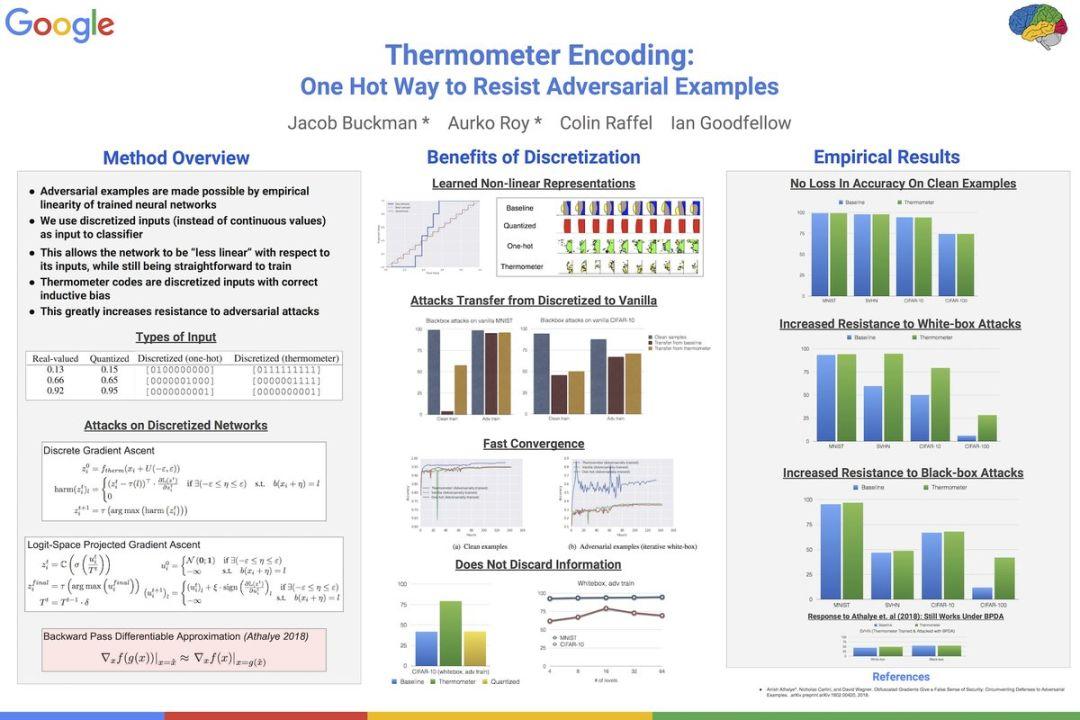
Thermometer Encoding: One Hot Way to Resist Adversarial Examples
Jacob Buckman, Aurko Roy, Colin Raffel, Ian Goodfellow
A Hierarchical Model for Device Placement
设备布局的分层模型
Azalia Mirhoseini, Anna Goldie, Hieu Pham, Benoit Steiner, Quoc V. Le, Jeff Dean
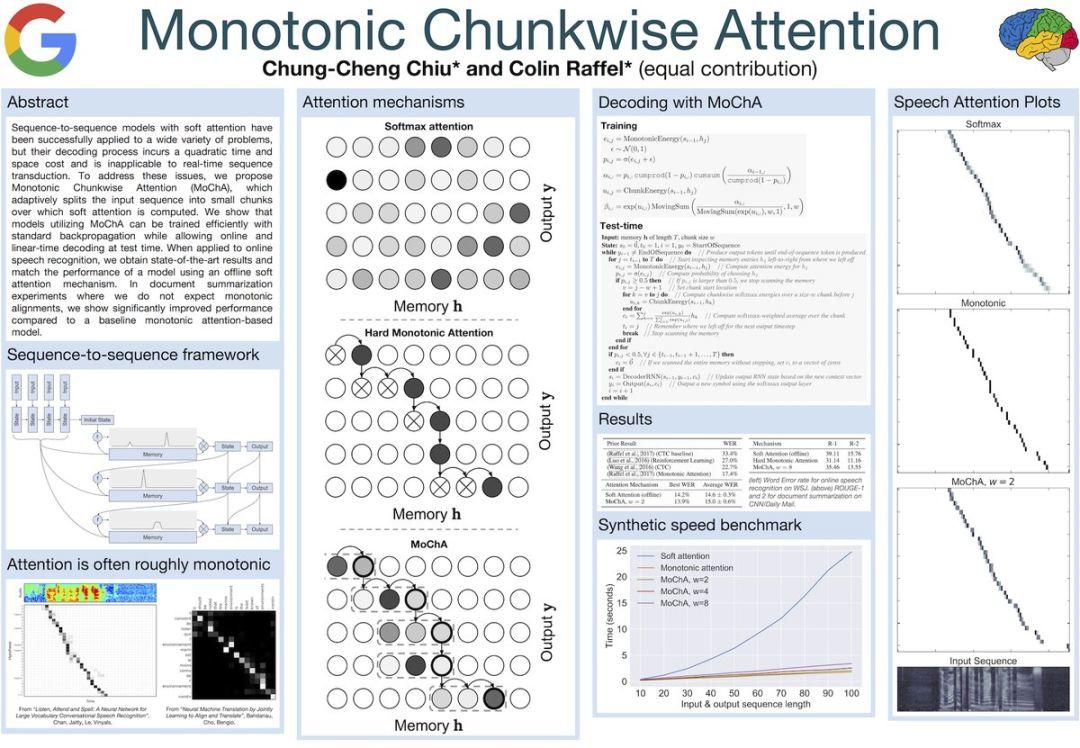
Monotonic Chunkwise Attention
Chung-Cheng Chiu, Colin Raffel
Training Confidence-calibrated Classifiers for Detecting Out-of-Distribution Samples
训练置信度校准分类器用于检测超出分配样本
Kimin Lee, Honglak Lee, Kibok Lee, Jinwoo Shin
Trust-PCL: An Off-Policy Trust Region Method for Continuous Control
Trust-PCL:用于连续控制的 Off-Policy 信任域方法
Ofir Nachum, Mohammad Norouzi, Kelvin Xu, Dale Schuurmans
Ensemble Adversarial Training: Attacks and Defenses
Ensemble对抗训练:攻击和防御
Florian Tramèr, Alexey Kurakin, Nicolas Papernot, Ian Goodfellow, Dan Boneh, Patrick McDaniel
Stochastic Variational Video Prediction
随机变分视频预测
Mohammad Babaeizadeh, Chelsea Finn, Dumitru Erhan, Roy Campbell, Sergey Levine
Depthwise Separable Convolutions for Neural Machine Translation
神经机器翻译的深度可分卷积
Lukasz Kaiser, Aidan N. Gomez, Francois Chollet
Don’t Decay the Learning Rate, Increase the Batch Size
Samuel L. Smith, Pieter-Jan Kindermans, Chris Ying, Quoc V. Le
Generative Models of Visually Grounded Imagination
Ramakrishna Vedantam, Ian Fischer, Jonathan Huang, Kevin Murphy
Large Scale Distributed Neural Network Training through Online Distillation
通过 Online Distillation 进行大规模分布式神经网络训练
Rohan Anil, Gabriel Pereyra, Alexandre Passos, Robert Ormandi, George E. Dahl, Geoffrey E. Hinton
Learning a Neural Response Metric for Retinal Prosthesis
Nishal P. Shah, Sasidhar Madugula, Alan Litke, Alexander Sher, EJ Chichilnisky, Yoram Singer,Jonathon Shlens
Neumann Optimizer: A Practical Optimization Algorithm for Deep Neural Networks
Neumann优化器:一种用于深度神经网络的实用优化算法
Shankar Krishnan, Ying Xiao, Rif A. Saurous
A Neural Representation of Sketch Drawings
素描图的神经表示
David Ha, Douglas Eck
Deep Bayesian Bandits Showdown: An Empirical Comparison of Bayesian Deep Networks for Thompson Sampling
Carlos Riquelme, George Tucker, Jasper Snoek
Generalizing Hamiltonian Monte Carlo with Neural Networks
Daniel Levy, Matthew D. Hoffman, Jascha Sohl-Dickstein
Leveraging Grammar and Reinforcement Learning for Neural Program Synthesis
利用语法和强化学习进行神经程序综合
Rudy Bunel, Matthew Hausknecht, Jacob Devlin, Rishabh Singh, Pushmeet Kohli
On the Discrimination-Generalization Tradeoff in GANs
论GAN中的Discrimination-Generalization权衡
Pengchuan Zhang, Qiang Liu, Dengyong Zhou, Tao Xu, Xiaodong He
A Bayesian Perspective on Generalization and Stochastic Gradient Descent
关于泛化和随机梯度下降的贝叶斯观点
Samuel L. Smith, Quoc V. Le
Learning how to Explain Neural Networks: PatternNet and PatternAttribution
学习如何解释神经网络:PatternNet和PatternAttribution
Pieter-Jan Kindermans, Kristof T. Schütt, Maximilian Alber, Klaus-Robert Müller, Dumitru Erhan, Been Kim, Sven Dähne
Skip RNN: Learning to Skip State Updates in Recurrent Neural Networks
Skip RNN:学习在递归神经网络中跳过状态更新
Víctor Campos, Brendan Jou, Xavier Giró-i-Nieto, Jordi Torres, Shih-Fu Chang
Towards Neural Phrase-based Machine Translation
基于神经短语的机器翻译
Po-Sen Huang, Chong Wang, Sitao Huang, Dengyong Zhou, Li Deng
Unsupervised Cipher Cracking Using Discrete GANs
使用离散GAN的无监督密码破译
Aidan N. Gomez, Sicong Huang, Ivan Zhang, Bryan M. Li, Muhammad Osama, Lukasz Kaiser
Variational Image Compression With A Scale Hyperprior
利用一个Scale Hyperprior进行变分图像压缩
Johannes Ballé, David Minnen, Saurabh Singh, Sung Jin Hwang, Nick Johnston
Workshop Posters列表
Local Explanation Methods for Deep Neural Networks Lack Sensitivity to Parameter Values
Julius Adebayo, Justin Gilmer, Ian Goodfellow, Been Kim
Stoachastic Gradient Langevin Dynamics that Exploit Neural Network Structure
Zachary Nado, Jasper Snoek, Bowen Xu, Roger Grosse, David Duvenaud, James Martens
Towards Mixed-initiative generation of multi-channel sequential structure
Anna Huang, Sherol Chen, Mark J. Nelson, Douglas Eck
Can Deep Reinforcement Learning Solve Erdos-Selfridge-Spencer Games?
Maithra Raghu, Alex Irpan, Jacob Andreas, Robert Kleinberg, Quoc V. Le, Jon Kleinberg
GILBO: One Metric to Measure Them All
Alexander Alemi, Ian Fischer
HoME: a Household Multimodal Environment
Simon Brodeur, Ethan Perez, Ankesh Anand, Florian Golemo, Luca Celotti, Florian Strub, Jean Rouat, Hugo Larochelle, Aaron Courville
Learning to Learn without Labels
Luke Metz, Niru Maheswaranathan, Brian Cheung, Jascha Sohl-Dickstein
Learning via Social Awareness: Improving Sketch Representations with Facial Feedback
Natasha Jaques, Jesse Engel, David Ha, Fred Bertsch, Rosalind Picard, Douglas Eck
Negative Eigenvalues of the Hessian in Deep Neural Networks
Guillaume Alain, Nicolas Le Roux, Pierre-Antoine Manzagol

Realistic Evaluation of Semi-Supervised Learning Algorithms
Avital Oliver, Augustus Odena, Colin Raffel, Ekin Cubuk, lan Goodfellow
Winner’s Curse? On Pace, Progress, and Empirical Rigor
D. Sculley, Jasper Snoek, Alex Wiltschko, Ali Rahimi
Meta-Learning for Batch Mode Active Learning
Sachin Ravi, Hugo Larochelle
To Prune, or Not to Prune: Exploring the Efficacy of Pruning for Model Compression
Michael Zhu, Suyog Gupta
Adversarial Spheres
Justin Gilmer, Luke Metz, Fartash Faghri, Sam Schoenholz, Maithra Raghu,,Martin Wattenberg, Ian Goodfellow
Clustering Meets Implicit Generative Models
Francesco Locatello, Damien Vincent, Ilya Tolstikhin, Gunnar Ratsch, Sylvain Gelly, Bernhard Scholkopf
Decoding Decoders: Finding Optimal Representation Spaces for Unsupervised Similarity Tasks
Vitalii Zhelezniak, Dan Busbridge, April Shen, Samuel L. Smith, Nils Y. Hammerla
Learning Longer-term Dependencies in RNNs with Auxiliary Losses
Trieu Trinh, Quoc Le, Andrew Dai, Thang Luong
Graph Partition Neural Networks for Semi-Supervised Classification
Alexander Gaunt, Danny Tarlow, Marc Brockschmidt, Raquel Urtasun, Renjie Liao, Richard Zemel
Searching for Activation Functions
Prajit Ramachandran, Barret Zoph, Quoc Le
Time-Dependent Representation for Neural Event Sequence Prediction
Yang Li, Nan Du, Samy Bengio
Faster Discovery of Neural Architectures by Searching for Paths in a Large Model
Hieu Pham, Melody Guan, Barret Zoph, Quoc V. Le, Jeff Dean
Intriguing Properties of Adversarial Examples
Ekin Dogus Cubuk, Barret Zoph, Sam Schoenholz, Quoc Le
PPP-Net: Platform-aware Progressive Search for Pareto-optimal Neural Architectures
Jin-Dong Dong, An-Chieh Cheng, Da-Cheng Juan, Wei Wei, Min Sun
The Mirage of Action-Dependent Baselines in Reinforcement Learning
George Tucker, Surya Bhupatiraju, Shixiang Gu, Richard E. Turner, Zoubin Ghahramani,Sergey Levine
Learning to Organize Knowledge with N-Gram Machines
Fan Yang, Jiazhong Nie, William W. Cohen, Ni Lao
Online variance-reducing optimization
Nicolas Le Roux, Reza Babanezhad, Pierre-Antoine Manzagol
写在最后:欢迎大家点击下方二维码关注我们的公众号,点击干货资源专栏或回复关键字“资源”获取更多资源推荐。关注我们的历史文章,一起畅游在深度学习的世界中。
另外:欢迎大家扫码加入我们的qq群。


 点击下方 | 阅读原文 | 了解更多
点击下方 | 阅读原文 | 了解更多
原创文章,作者:fendouai,如若转载,请注明出处:https://panchuang.net/2018/04/30/08e7bed3c4/

